|
Note Added on 10/22/14 - See these
Revisions
9.1 Objectives
This Lab contains 2 parts. In Part A, to be done in lab, you will:
- Create a Digital Elevation Model from LiDAR LAS files
- Modify an existing Geodatabase and map to include historical
river channel outlines
- Print layouts and instructions for data collection to take with you to the field;
- Export your project to an ArcPad v.10 project;
In Part B, to be done during the following lecture period, you will:
- Learn procedures for capturing GPS points, lines and polygons with ArcPad
10 software;
- In pairs, practice with a Trimble Nomad GPS receiver capturing
the locations of polygons and lines on the Campus Main Building Mall.
9.2 The Problem and the Data
The Nueces River in Uvalde County, TX is incised into and
has its headwaters on the Edwards Plateau, a large, broad expanse of Cretaceous
limestone that extends from Austin south and west to
near Van Horn, TX (see below). Groundwater beneath the Plateau in our area of
study is contained within the Edwards-Trinity aquifer.
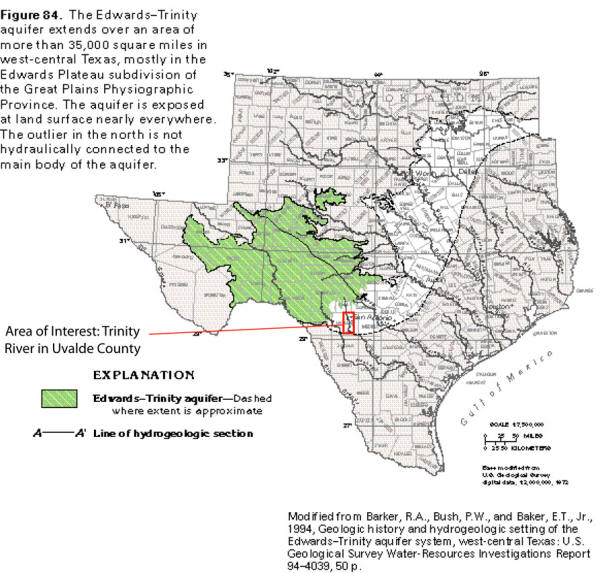
(Modified from
http://pubs.usgs.gov/ha/ha730/ch_e/E-edwards_trin1.html)
Groundwater models that make
predictions about aquifer characteristics rely in part on knowing how and where
an aquifer receives surface water
("recharge", "recharge zone") and how water is lost ("discharged"; e.g. springs,
withdrawal by wells). Recent gauging studies of the
Nueces River show it to be a potential site of recharge for the Edwards-Trinity
aquifer, as indicated by flow rates and volumes that are variable along short
reaches of the river. Near our field site, downstream gauging
sites show less flow than those upstream - the river is losing water
into the subsurface between sites. Two end-member hypotheses
might explain this loss:
-
Nueces River water is traveling downward into the
Edwards-Trinity
aquifer through fractures in limestones in the river bed;
-
Water is being lost into the shallow subsurface
(but not the Edwards-Trinity aquifer) via travel through relatively thick and
highly permeable Nueces River fluvial deposits (gravel and sand) and flowing in buried river
channels that bypass surface gauging
stations.
We will evaluate these hypotheses by:
- constructing a very high resolution elevation model of the river and its surrounding that will aid in
- constructing a geologic map of older, younger and modern river deposits, and of the present and relatively
recent river channels;
- noting the density and measuring the orientation of
any bedrock fractures in the river bed.
Data
For the GIS lab portion of the project we will work with
the following data:
- UTM zone 14 NAD83, LAS-format Airborne LiDAR files acquired during
flights in January, 2014, provided by Marcus Gary at the
Edwards Aquifer
Authority.
- UTM zone 14 NAD83, LiDAR intensity "maps" (panchromatic raster images) with
a resolution of 0.5 m, clipped to the area of interest;
- UTM zone 14 NAD83, 1 meter-resolution digital orthophotos acquired in
March,1996 and June, 2012, clipped to the area of interest,
from TNRIS and
Google Earth;
- UTM zone 14 NAD83 1:24,000 Digital raster graphs, clipped to the area of
interest, from TNRIS;
- NAD83 edited National Hydrological Dataset (http://nhd.usgs.gov) )
files for water bodies, springs and flow lines;
- A geodatabase that contains some of the files above, as
well as a feature dataset of vector files for a preliminary
geologic map that I completed
last week.
**Download the Lab_7_data folder to your flash drive,
NOT YOUR NETWORK STORAGE.** This file contains 2.43 Gb of data and
may take up to 5 minutes to download.
9.3 Working with LiDAR data in ArcGIS
LiDAR data are fundamentally clouds of points ("point clouds") with
XYZ coordinates and attributes. They are commonly distributed in LAS (LASer)
format files, a non-propriety format that has gained
wide acceptance in recent years. ArcGIS have extensive tools for importing and
working with LAS files. Our goals for this part of the lab are to:
- Import LAS files into ArcGIS and examine their
properties
- Create a raster digital terrain model ("DTM") from
these vector files
- After checking to be sure that the Spatial Analyst
and 3D Analyst Extensions are checked on in a blank
ArcMap document, open the ArcCatalog window
inside of ArcMap, right-click on the Lab_7_data "LiDAR"
folder and select "New", create a "LAS Dataset" and
rename it Nueces.lasd. This creates a container
into which we can import LAS files. A "LAS
Dataset" (.lasd) has special properties that allow us to
examine some of the unique features of LiDAR data and is
required for some LAS processing tools.
- Add the four LAS files (each is a tile of a single large
area and has a file name that ends with .las) to this new LAS Dataset by right-clicking on
the LAS
Dataset icon, selecting "Properties...", the "LAS Files" tab
and the "Add Files..." button (shown below).
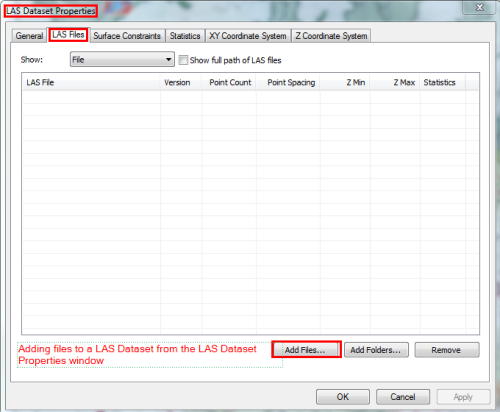
- Examine the Properties of the imported
files. Note that each file contains 21-23 million points
- we will be working with over 88 million points in this
exercise (!) - that are spaced at about 0.35 meters (as
shown below). The maximum (Z Max) and minimum (Z
min) elevation of the points in each file is also
listed.
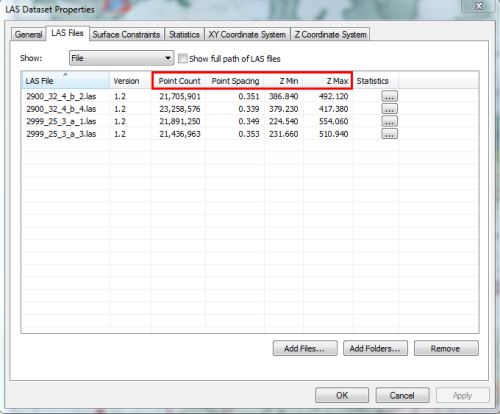
- Open the "Statistics" tab and click
the "Calculate" button - this may take some time...
- As shown below, the result provides
Statistics on two important parameters. This will be
important later - pay attention as you read on...
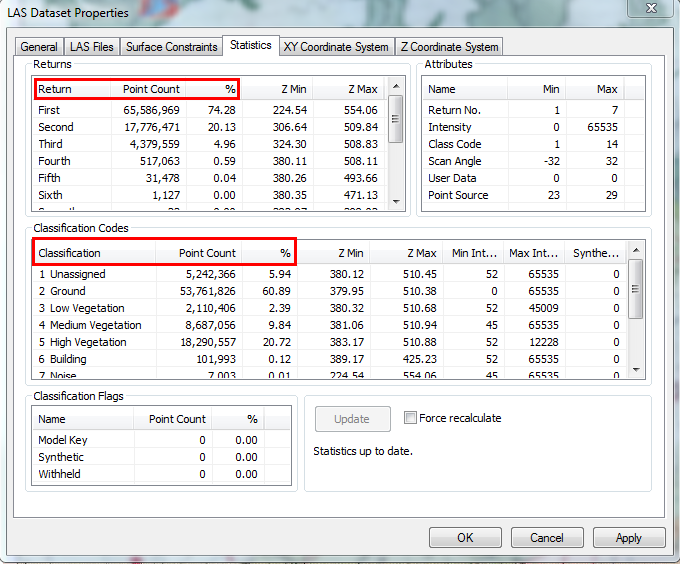
LiDAR data consist of multiple "Returns" (upper left
table): light pulses
that bounce back to the instrument. A "return" is a specific arrival at the instrument
from a single laser pulse. For each pulse, these are
classified by whether they return quickest ("First returns") or at
successively later times (Second, Third, Forth, etc.). As
shown in the statistic table, the number of returns from laser pulses
diminishes with time - ~75% of all returns are first returns whereas fewer
than 5% are third returns.
During post-processing, most returns are
assigned a standard Classification Code (middle table) based on the origin of the return. The
distinction between return number (i.e first, second, etc.) and Classification code is important - it is easy
to understand that for partially vegetated areas some first returns will
come from the ground whereas others will from the tops of trees. We are interested
in returns that are classified as ground returns - coded 2 - but note that Code 9
are water returns and Code 3-5 are vegetation returns. For this
dataset, points with ground returns are most abundant (~61% of all data)
but note that 6% of the points had returns that were not classified
("unassigned" - Code 1) and ~32% of the points had returns from
vegetation (Codes 3, 4, 5).
The strength or Intensity of returns (middle table) are also measured
(on a scale of 0 to 65,535) - some pulses come back strong, some weak.
Strong returns come from highly reflective surfaces, weak from surfaces
that absorb some of the laser pulse. Minimum and Maximum Intensity
measurements are listed for each classification.
-
Drag the Nueces LAS Dataset from
ArcCatalog into a blank Arc Map window. You
have just loaded the entire point cloud, all ~88 million
points.
-
The ArcMap window shows only the
outline of each of the four data tiles (this keeps
redrawing times reasonable) until you zoom to a specific
area.
- Zoom into the lower right corner of the lower right
tile. Your screen should look like the image
below but without the pink, which on your map will be
white. You are looking at a two dimensional view
of a point cloud, color coded by elevation - the ArcMap
table of contents shows the range of elevations (in
meters) represented by each color. White is an
unfortunate color choice for an elevation interval
because it also represents background areas of no
points. Choose an unused color (I chose pink) and
replace it by changing the symbology of the top-most
point in the table of contents.
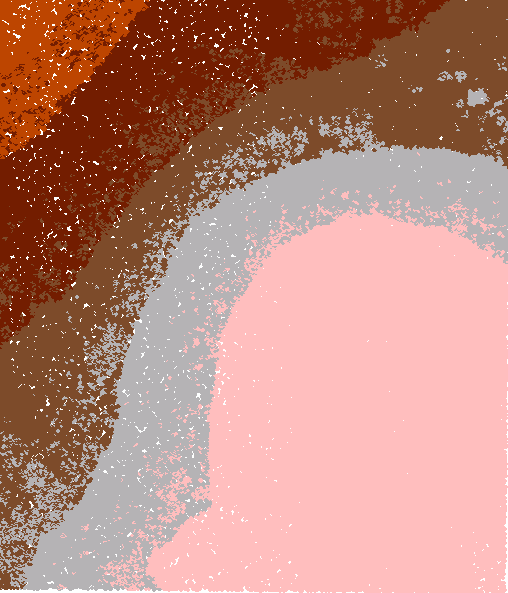
- Open the LAS Dataset toolbar (Customize>Toolbars>LAS
Dataset), which contains a variety of options for
viewing and manipulating point clouds.

If the toolbar is grayed-out, you will have to turn on
the Spatial and 3D analysts extensions, as indicated in
the step 2 above.
-
Want to see something astounding? Use the Profile Tool (second
from right on the LAS Dataset toolbar) to construct a
short vertical profile (a cross section) through the point
cloud. A tool tip, visible when hovering the mouse
over the tool, explains how. These are unfiltered points, so we are
viewing returns irrespective of Code Classification.
We won't spend much time with this tool but it's just to
cool to ignore!
Explore the other tools on
this toolbar - they provide very powerful ways to view
and interactively filter LAS point clouds.

- Can't resist one more trick with this toolbar...
create a surface elevation model (a TIN) with the Elevation tool
on the toolbar (see below) by zooming in or out of your
Map.
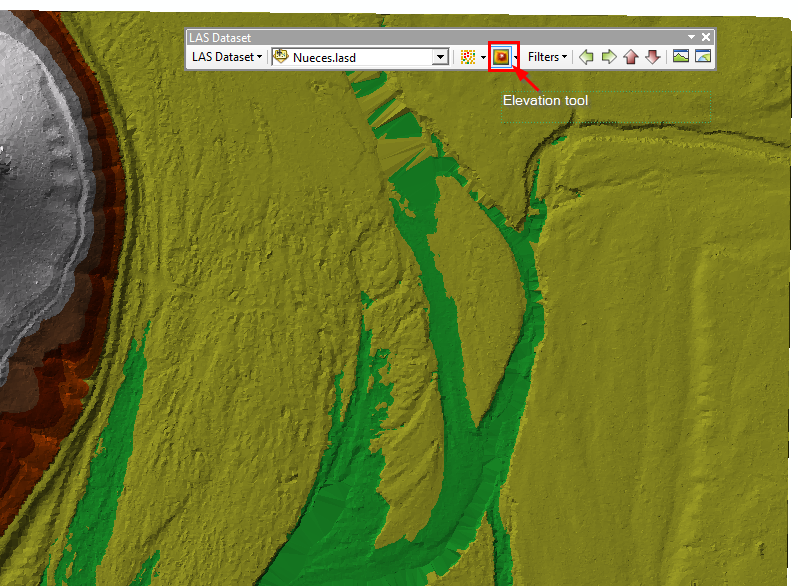
The maps created with the LAS Dataset toolbar are
visualizations created on-the-fly, not permanent products. As
such, they are of limited use for analysis. We would like to
create a permanent raster dataset from this LiDAR (vector)
point cloud - specifically a high resolution, "bare earth" Digital
Elevation Model (DEM; nomenclature varies - LiDAR-derived bare earth
rasters are commonly referred to as Digital Terrain Models (DTMs)).
This will require a tool from ArcToolbox.
- Using the Search window in ArcMap, search "LAS to
Raster" for a the tool needed for this conversion.
- IMPORTANT - Before running this tool make sure a)
that you are zoomed completely out and can see the red
outlines of all of the data tiles in ArcMap; b) that the LAS Dataset
Toolbar has the "Filters" tool drop-down set to "Ground" and the
Point tool drop-down set to "Elevation". These choices
will be recognized by the "LAS Dataset to Raster" tool
in ArcTool box if we take care to choose the ArcMap
layer as the Input Dataset and not browse to and choose
the original LAS Dataset.
- Open the "LAS Dataset to Raster" tool from
ArcToolbox or the Search window. If not already
shown, show the Help for this tool. USING THE DROP-DROWN
ARROW AND NOT THE FOLDER ICON (see graphic below),
select Nueces.lasd as the Input the LAS Dataset
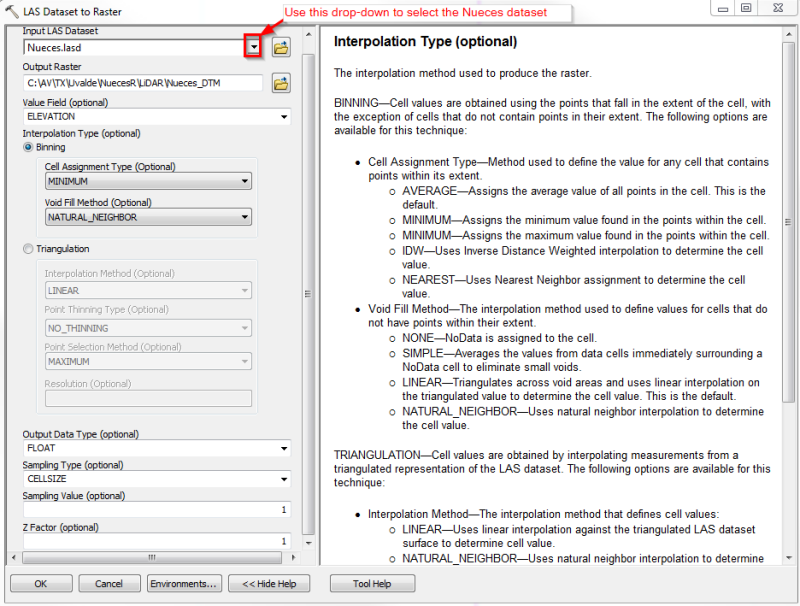
- name your output raster Nueces_DTM, to be
stored in your LiDAR folder of Lab_7_data folder
- Value
Field is ELEVATION,
- Interpolation Type is Binning with
"MINIMUM" (this is a bare earth model...) as the Cell
Assignment Type and NATURAL_NEIGHBOR as the Void Fill
Method.
- DO NOT CLICK OK YET -we
need to specify the raster resolution (cell size), which
requires some thought. The raster cell size should
never be smaller than the point spacing of returns.
As seen in the statistics, the average return spacing is
about 35 centimeters. This is for all returns,
irrespective of classification. We are using Class
2 (ground returns) only, not all points, so the spacing
for these returns may be significantly greater (3x to 4x
greater- not all points will have ground returns) . A conservative approach for a bare earth DTM is to set the raster cell size to ~ 3 times the
average return spacing. For our data this means
about a
1 meter cell size, SO SET THE "Sampling Value" TO 1.
- Z Factor is 1. Click OK. This will take a few minutes...
If all went well your DTM should look like the one
below.
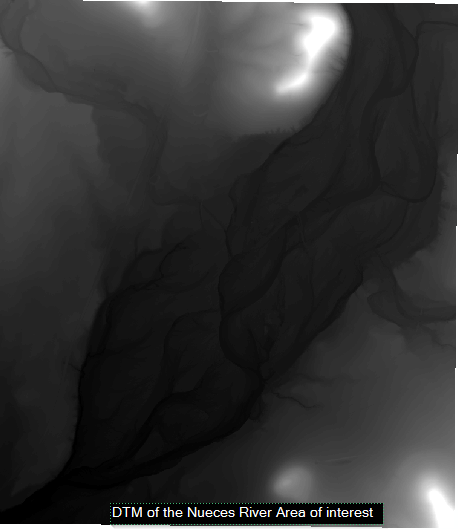
This new DTM will be easier to visualize
in shaded relief.
- Using the Search window, find
the Hillshade tool in ArcToolbox and create a Hillshade,
like that created in Lab last week (Part D). By
changing the symbology Stretch Type to Percent Clip (Min
2, Max 2) you Hillshade should resemble the one below.
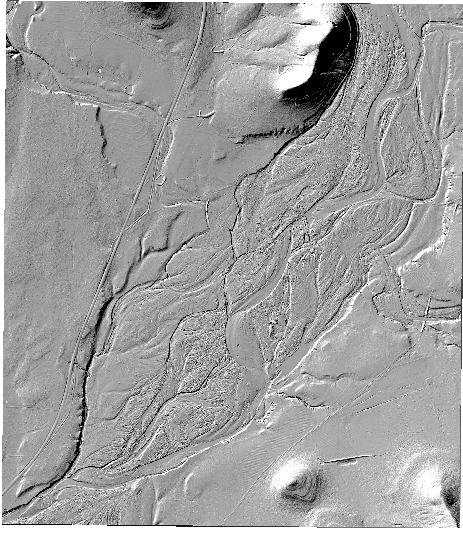
9.4 Constructing a Preliminary Map for Field
Work
In the interest of time, a preliminary geologic map of the area of
interest has been constructed from the LiDAR dataset, 2012 orthophotos,
NHD data, and prior knowledge of the geology of the region. Your
task is to add to the map by digitizing the Nueces River channel as it
existed in 1996.
-
Open the map document in the
Lab_7_data folder and add your DTM and Hillshade to it.
The Rocks and terrace deposits layer contains
polygons for the following rock units:
-
The active river
channel: least vegetated, narrowest
portion containing the modern river and
its point bars
-
Terrace level 4 (T4):
river and stream deposits at slightly
higher elevation that the active channel
(or stream beds). The hillshade of this
unit shows a characteristic plumose
texture of downstream diverging rill and
elongate lobes formed during flooding of
the active channel. Some of the
abandoned subsidiary channels within
this unit contain standing water and
appear to have been active channels
during high flows or floods.
-
Terrace level 3
(T3): At a slightly higher elevation
than level 4 terraces, these deposits
are characterized by relatively smooth
surfaces that don't appear to have been
greatly disturbed or reworked by floods
in recent times. Where they border T4
they are densely vegetated by large
trees.
-
Terrace level 2 (T2):
Flat smooth surfaces in stream valleys
on the NW and SE sides of the Nueces
River that are elevated above T3.
-
Terrace level 1 (T1):
the highest relatively flat surfaces in
stream valleys and along the Nueces
River. Contacts with bedrock unit
Ku are difficult to discern and some of
what is mapped as Ku may be T1.
-
Undivided Cretaceous
rocks: At the lowest elevations, this
unit includes uppermost Glen Rose
Limestone which by weathering
characteristics (gentle uniform slopes)
appears to be soft, easily weathered
marl or claystone. The highest
elevations are likely capped by
resistant lowermost carbonates of the
Devil's River Formation.
-
Create a Line feature
class, "River_1996", in the "Geology"
Feature Dataset of the Nueces_River_2014" geodatabase.
-
In the ArcMap Table of Contents turn
off all but this layer and the 1996 USGS orthophoto.
Using the criteria described above for the present
active river channel and by analogy to how it looks in
comparison to the 2012 orthophotos, carefully map the
outline of the active channel as it existed in
1996. The procedure will be exactly like the
digitizing you did in Lab 4. There are significant
differences between the 2014 and 1996 channel that may
reveal where buried channels might be today.
9.5 Printing Field Maps
- Layout your finished map
to fit on 8.5x11" paper, place a UTM grid on top
of it and print color copies for use in the
field of:
- The hillshade with unit
contacts (but not
rock and terrace units) and
the 1996 channel outline
clearly visible
- The 2012 orthophoto
overlain by 70% transparent
Rock and terrace units, with
the outline of the 1996
channel on top.
Bring these maps with you on the field trip.
9.6 Trimble Nomad and ArcPad v. 10
GPS data collection using the Trimble Nomad units is done with ArcPad software. ArcPad is a streamlined version of ArcGIS
that is equipped with very easy to use GPS capture tools. ArcPad 10 is
installed on the classroom computers and our field data collection units. Version
10 is a major revision
from earlier releases. Before getting a little ArcPad
practice, we first need to convert the ArcGIS map document file into an
"ArcPad Project". An automated tool exists to do so, which converts
most rasters to jpeg images, the geodatabase to an ArcPad exchange format
database (.AXF),
and makes data entry forms from the domains for each Feature Class.
We can "check out" the empty Feature Classes for editing then, upon
return, "check in" the same, permitting the software to automatically
update the geodatabase!
An important note about ArcPad versions:
- ArcPad 10 represents a significant departure from earlier
versions (i.e. 8.x and below). "ArcPad Projects" created for ArcPad
10 will not run on 6.x software, and vice-versa.
The ArcMap toolbar for creating ArcPad projects in versions of
ArcGIS 9.1 and higher contains separate tools for creating ArcPad 8.x and 6.x (or lower) projects. It is thus important to know
which version of ArcPad is installed on your field data collection
units. Our Trimble Nomads and Xplore tablet PCs are
currently running ArcPad 10, as are
the computers in the lab.
A. Preparing the Map Document for ArcPad (version 10).
- Open your map document.
- Switch to Data View mode
(if you're in Layout mode) and zoom to your
Hillshade layer. This is an important step!
- Make sure the "Point"
and Rock Unit contacts Feature Classes
are present in the Table of Contents of the map. These have coded-value domains already
built that will allow use of ArcPad data entry forms. These are
the files you will populate with GPS measurements.
- Change the symbology of these files to colors/symbols that will
be recognizable on both a white background and the DOQ. Red works
well, as does light blue. This is much easier to do now than later
in ArcPad.
- If not already on. Turn on the ArcPad Data Manager
toolbar (Tools>customize...) shown below.
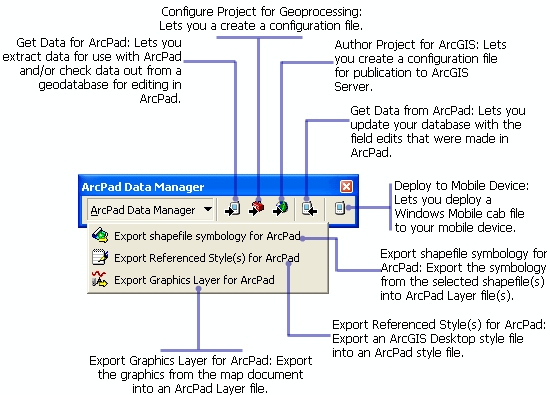
- On the ArcPad toolbar, click the "Get Data for ArcPad" button.
In the "Select Data"
window, shown below, there are several options for how to export data
under the "Action" column. The "action" performed
on each layer can be set individually or for all layers
by clicking on the word "Action" to display the menu
shown in the figure below. Strictly speaking, we
can either "Checkout" a layer for editing or "Copyout" a
layer. A "Checkout" is only allowed for Geodatabase
layers; shapefiles or other layers not in a geodatabase
can be "Copied Out". A "Checkout" creates a compact
geodatabase that can only be read by ArcPad in a so-called "AXF"
(Arc Pad Exchange Format) file. There are
numerous advantages to AXF files - read about them on
page 573 of the ArcPad Help PDF in the Lab 8_data
folder. For our purposes, the principal advantage
is the automatic creation of forms (based on our geodatabase domains)
that can be edited in the field, and the ability to directly import the
results into our ArcGIS project after returning from the field.
The main disadvantage is that a Checkout is tied to a specific ArcGIS
file, your project, on a specific computer. After data
collection, the file can only be checked into your
project (into your
geodatabase) on the computer you created it on. An AXF file can
not be edited by any software, so if you are unable to check it back in,
for whatever reason, you've lost all of your field results.
The other option, "Copyout", creates a Shapefile that can be read by ArcPad. Unfortunately, this option does not automatically create
forms for field editing, nor can results be directly checked back into
your ArcGIS file after field work is done. The shapefiles can,
however, be downloaded from the receiver onto a computer and loaded into
your ArcGIS project by the same process you would use to load any other
shapefile. "Copyout" layers are exported to ArcPad as "background
layers" that either can be editable or not.
We will cover several bases by "Checking Out" the two files we will
edit in the field (Points, Rock unit contacts), "Copyout"
the other Feature Classes (those we will
not edit) as "read-only" background
shapefile. I will explain the rationale during lecture. To
do this requires specifying the "action" for each layer individually.
- Click the black arrowhead to the left of your "Points"
Layer and choose "Checkout for disconnected editing in ArcPad>data based
on defined extent". Do the same for the Rock Unit contacts
layer.
- For all other vector layers choose "Export as Background data (to
AXF layer)>Make Read Only"
- Do not export the raster files.
- Click Next.
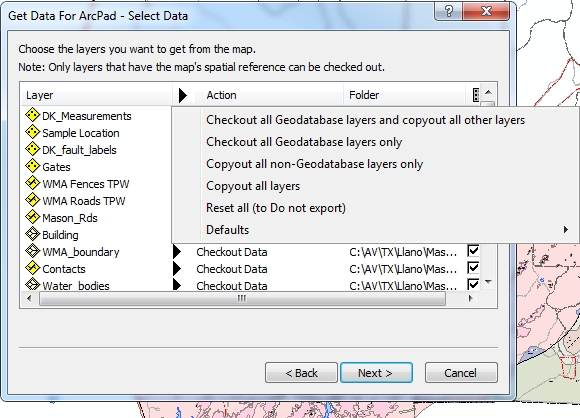
- The next window, "Select Picture Options", is not
applicable to this project; Click Next.
- The final window lets you set the spatial extent (current
display extent or full extent of the layers), lets you select whether to
limit the fields to those that are visible in the attribute tables and
the features to those specified in the layer's definition query, lets
you specify a name for the folder that will store the data, and lets you
create an ArcPad map file (the equivalent of an .mxd file) for the data,
as shown in the "Get Data For ArcPad" screen capture below.
- Enter a name for the folder, e.g. "ArcPad_Nueces_XX" (where
XX are your initials) and a
Map Name that includes your last name or initials (e.g. NuecesRvr_XX).
- Making sure first that your display shows the entire area of
interest (i.e. you are zoomed to the area of interest), make the selections shown in the figure below, setting the
"Where do you want the folder to be stored?" to an appropriate location
on your network storage space.
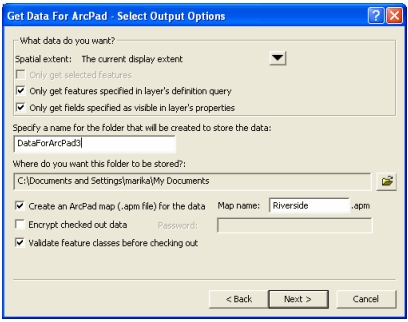
- Click Finish and wait for the data to be created.
- With help from Ali, transfer your new "ArcPad_RR_XX" folder
to your Trimble Nomad (these will be shared, but each partner can load a
project). The Nomad units have a folder called "My
Documents" that should be used for all ArcPad
data and files.
- Print a color copy of the PDF file "ArcPad Quick Reference", in color,
from All Programs>ArcGIS>ArcPad 10>Help>ArcPad Quick Reference.
You will find this exceptionally useful for Part B of this lab, and for
the field trip.
PART B
Practice with ArcPad in the field
9B.1 Using ArcPad - some practice with the basics
Editing in ArcPad is, in most ways, much simpler than Editing in ArcGIS.
The basic concept is the same in both - data are entered into a file that
is open for editing. Below are a few of the basics. A complete description of the
software can be found in the ArcPad 10 folder in the class folder.
- On a classroom computer, open ArcPad 10 from the Start Button>All Programs menu in Windows.
- Click the folder button at the top of the ArcPad window and select
"Open Map", then browse to your ArcPad map file, the one with
the ".apm" extension, in your "ArcPad_RR_XX" folder.
- Five toolbars are immediately available (called Main
Tools, Browse Tools Edit Tools Quick Capture and Navigation), though
only one at timeis displayed (this saves real estate on small
screens).
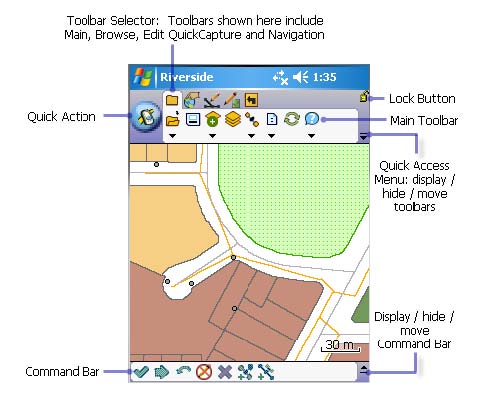
- Click the Main Tools icon (on the left in the figure above) and then
select the Layers icon
 to
open up a Table of Contents, like that on the left below. The
diagram on the right, from an earlier version of ArcPad, has many of the
icons labeled. to
open up a Table of Contents, like that on the left below. The
diagram on the right, from an earlier version of ArcPad, has many of the
icons labeled.
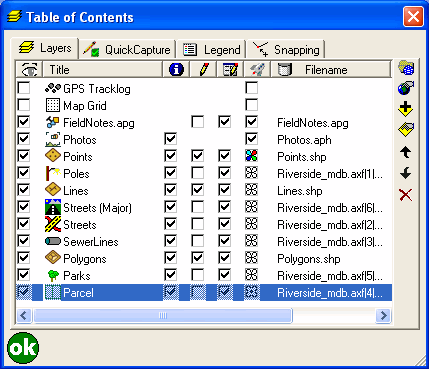 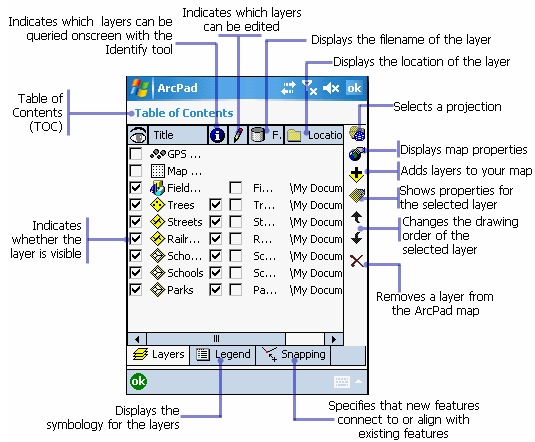
-
The check boxes on the left in the "eye" column turn
layers on and off for viewing. The check boxes in the "pencil"
column turn layers on and off for editing. This is similar
to setting the "Target" of the editing toolbar in ArcGIS, except that
in ArcPad more than one layer can be open for editing at a time. In
the Table of Contents to the right above, none of the layers are open for
editing. In the table of contents on the left above three layers
(Point, Line, Polygon) are open for editing. Finally, the check boxes below the Info icon (i) make layers available for query.
Layer Properties can be accessed by an icon on the right, as can other
options denoted by icons that should be familiar from ArcMap. The
column with the "rocket ship" icon at the top is the QuickDraw mode;
checking boxes here allows the different layers to be drawn to different
"coarseness" so they will render quicker on screen. The QuickDraw
mode is accessed from the Editing Toolbar.
-
Turn on the "Point_XX" layer for editing and close the
Table of Contents.
-
Turn on the Edit toolbar by selecting it from top row of
icons, as shown below.
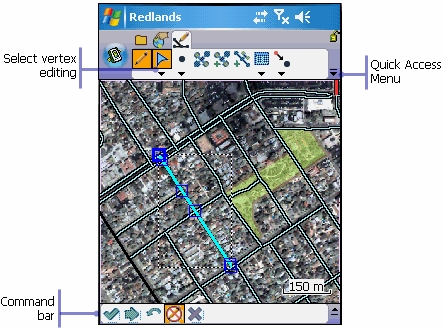
-
The function of the edit tools are shown in the figure
below. This is the most important toolbar for the field work
this weekend. Learn it.
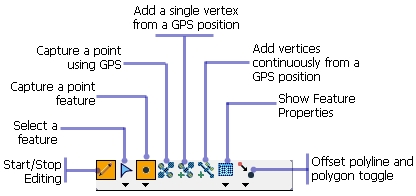
To add a point to the map, Click the pencil tool, select
the layer you want to edit, click the "Capture a point
feature" button, (Capture of polyline or polygon features, if open
for editing in the TOC, can be selecting from the drop-down menu below
the "capture a point" feature icon). Then click a location on the map. A data entry form should then open,
allowing you to select the feature name from a drop down list.
To do outdoors: To add a GPS location as a point, click instead the
"Capture a point using GPS" button. (When the GPS is active this
button is not grayed-out.)
-
To add a line, click the Pencil icon, select the polyline
feature class you want to edit, click the drop-down arrow below
to the "Capture a point feature" button, and select "Polyline".
Click on the map where you wish to place a polyline vertex, click and drag
on the next spot where you want a vertex, and continue this process until
finished. The line is not completed until you click the "Proceed
or complete feature" button at the bottom of the ArcPad window
(shown below).

-
To do outdoors: To add GPS vertices to a polyline, as above, click the "Capture a polyline"
button (beneath the capture a point button), click the "Add a single
vertex from a GPS position" button and continue clicking this button
every time you want to add a vertex to the line. To finish the
line, click the "Proceed or complete feature" button, the
green arrow icon. The line is not completed until you click the
"Proceed or complete feature" icon.
The GPS must be activated before
the GPS buttons are available.
-
A similar procedure is used to capture polygon vertices
with and without GPS.
-
You can delete features by selecting them with the
Arrow button (shown above) and then
clicking the "Edit vertices" button.
-
Practice adding and deleting lines, points and polygons to the map.
Name the features test1, test2, etc. so that, if needed, you will be able to recognize and
delete them later.
-
Browse the ArcPad manual in the digital books folder,
particularly the sections on editing. Download and print the
ArcPad Quick Reference
page.
-
Before loading your ArcPad folders to the field GPS
units, clear each of your test features, or don't save your project after
editing.
9B.2
-
Before our field trip, you need practice using ArcPad with a GPS.
An ArcPad project for the Main Building area, identical to the ArcGIS project
you constructed in Lab 6, is loaded on all instruments. Take
your instrument outside, open the Main Building project, and practice
capturing lines, points and polygons using the ArcPad GPS
tools described above.
-
Specifically, capture the features listed and
labeled in the photo below.
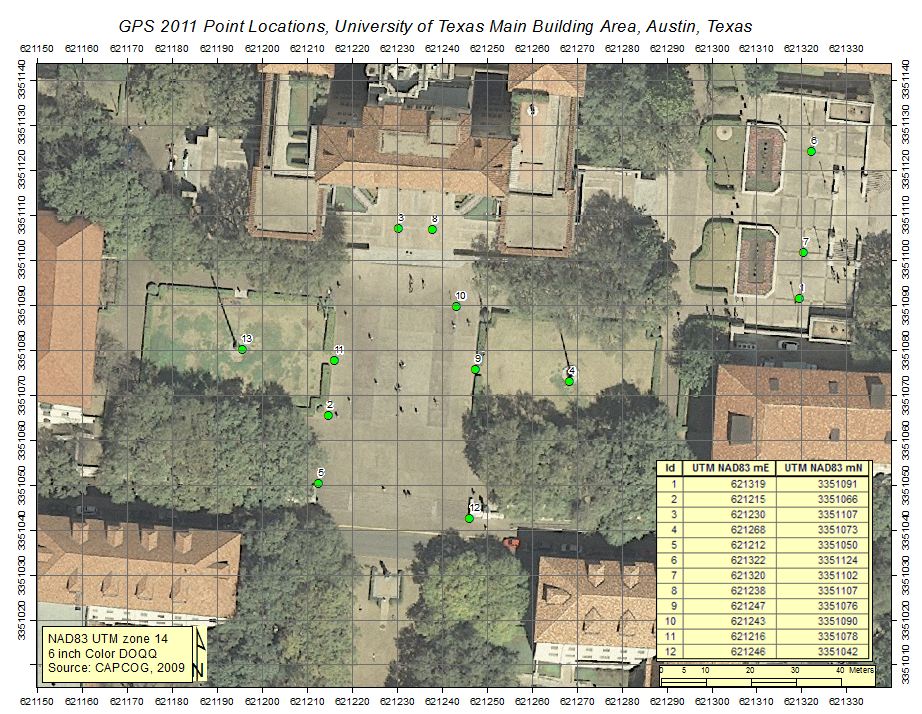
- Points: Points at the two flagpoles.
- L1, L2, L3: Polylines with at least 3 GPS vertices at the edges of
sidewalks.
- P1, P2: Polygons outlining grass areas - capture the vertices
of the 4 corners with
GPS. s - capture the vertices
of the 4 corners with
GPS.
You're done.
|
 |


















